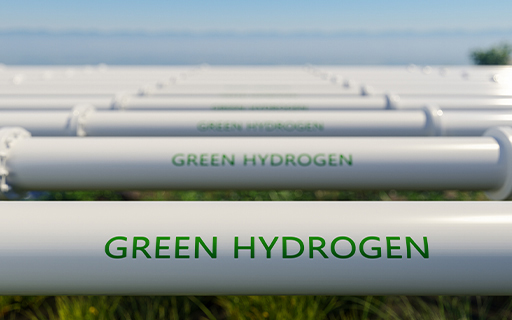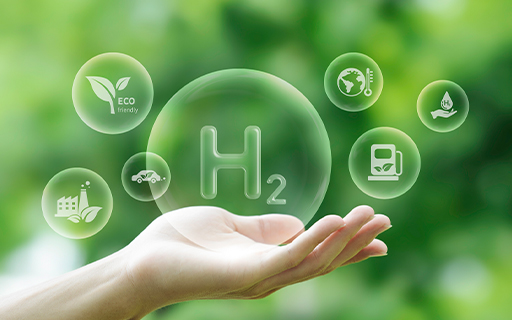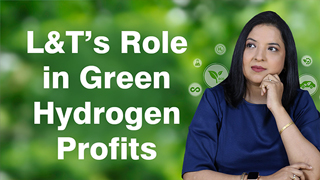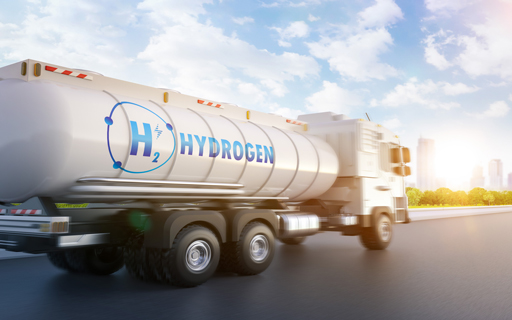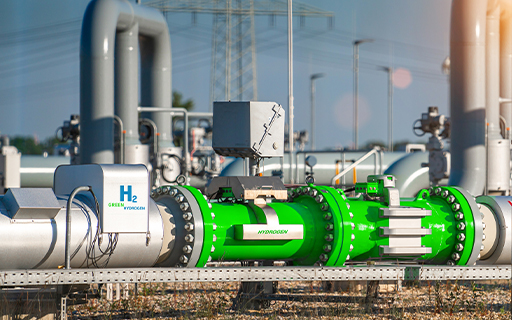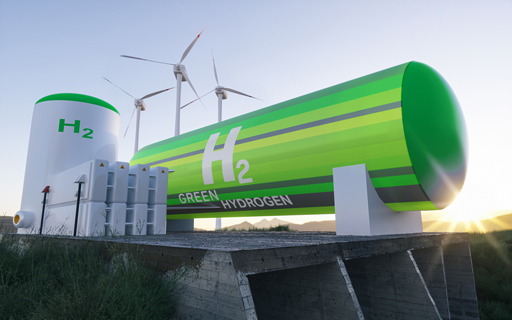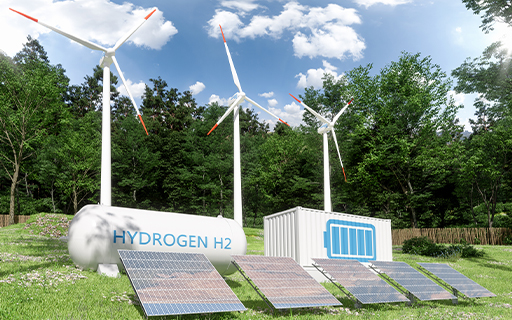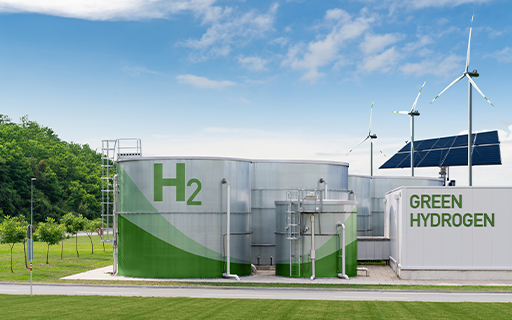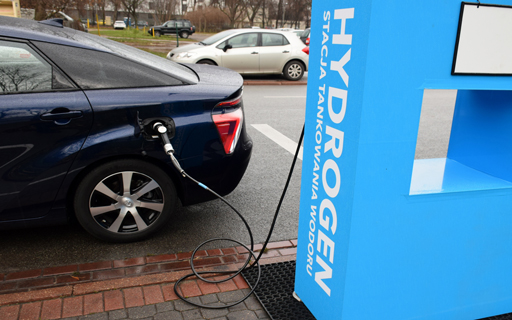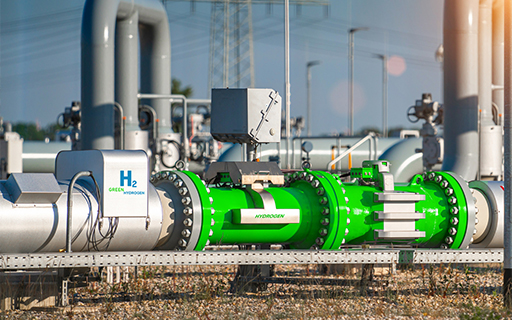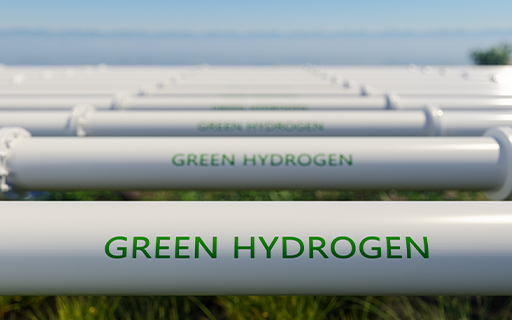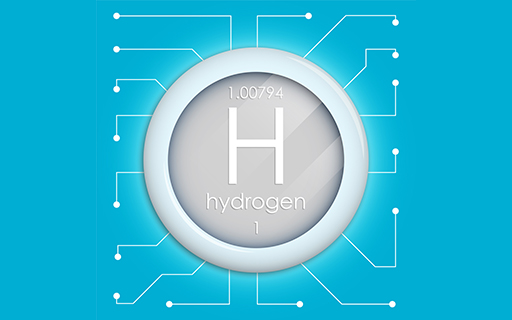India's Third Giant Leap
This Could be One of the Biggest Opportunities for Investors
- Home
- Outlook Arena
- Green Hydrogen Stocks - All Your Questions Answered
Green Hydrogen Stocks - All Your Questions Answered
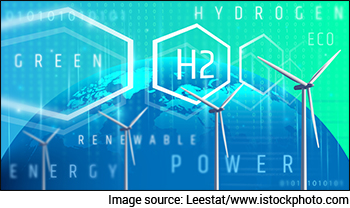
There is a growing consensus that green hydrogen could be the fuel of the future.
The environment friendly fuel has emerged as one of the strongest candidates for helping decarbonize sectors less dependent on electricity, taking us a step closer to carbon neutrality.
While this is still in the nascent stages, it is quickly turning into an investing megatrend. And if you can navigate the green hydrogen landscape well, you are bound to succeed.
But before you go fishing for green hydrogen stocks, there are things you need to know about green hydrogen. This will help you understand the industry from the ground up.
Here are a few frequently asked questions on green hydrogen and the opportunity it holds for investors in the future.
#1 What is green hydrogen? How is it different from other types of hydrogen?
Green hydrogen is clean hydrogen produced via electrolysis. It is not a newly discovered or invented element. It is the same hydrogen in our periodic table, only produced differently.
The primary difference between green and other forms of hydrogen (grey and blue) is that it is produced sustainably, without harming the environment.
You see, 95% of the hydrogen widely used and produced today through a process called “steam methane reforming”. But along with hydrogen, it produces massive amounts of carbon monoxide and carbon dioxide. Hence this type is known as “grey” hydrogen.
Blue hydrogen, on the other hand, is just a cleaner version of grey hydrogen. However, there are some controversies around blue hydrogen as it inevitably results in some form of carbon emissions.
Unlike blue and grey hydrogen, green hydrogen is the cleanest form of hydrogen. It produces no carbon emissions.
This makes it the top candidate to meet over 25% of the world’s energy needs in the next decade. However, at the moment, less than 0.1% of hydrogen is made this way.
#2 How is green hydrogen produced?
Green hydrogen is produced via electrolysis.
This process entails the use of electrolysers that split water (chemically known as H2O) into hydrogen and oxygen using electricity from renewable sources.
While oxygen is released into the environment, hydrogen is used for consumption.
Electrolysers consume a large amount of energy. However, most of it comes entirely from renewable sources. Therefore, the entire process does not emit any direct pollutants or greenhouse gases. This makes it a versatile and scalable element for use in different applications.
#3 What are the advantages of using green hydrogen?
Green hydrogen, like the rest of the hydrogen, is light-weight, energy dense and easy to store.
It can be transported as a gas by pipelines or in liquid form by ships, much like liquefied natural gas (LNG).
Unlike batteries that can't store large quantities of electricity for extended periods, hydrogen fuelled cells can store hydrogen in large amounts for a long time.
They can also outperform li-ion cells when it comes to higher ranges and speeds. Refuelling them also only takes a few minutes.
Moreover, their manufacturing process does not emit any greenhouse gases, crowning it the sustainable energy fuel source of the future.
#4 How does it compare to other sources of renewable energy?
Green hydrogen, much like solar and wind, is also a clean energy source; meaning it does not emit any carbon emissions.
However, unlike its renewable peer, it is produced using energy from other renewable energy sources.
Solar and wind offer hopes for achieving emission reductions, but they also present some challenges such as daily and seasonal fluctuations in sunlight and wind availability.
Apart from this they also demand considerable energy storage capacity to store any surplus power generated during periods of high wind and solar availability.
Green hydrogen, on the other hand, can be manufactured around the year.
#5 Why is there so much hype around green hydrogen? Is green hydrogen the fuel of the future?
Green hydrogen carries the potential to transform a myriad of industries, competing with fossil fuels on an equal or higher ground.
That is because, pound for pound, hydrogen packs in almost three times as much energy as fossil fuels. This means less amount of hydrogen is needed to do any work.
But for hydrogen to make a significant contribution to clean energy transitions, it needs to be adopted in sectors where it is almost completely absent, such as transport, buildings and power generation.
Green hydrogen can be used to power homes and converted to methane for the feed industry. Green hydrogen can also fuel cars, trucks, ships and even planes.
Companies across the world are experimenting with green hydrogen for vehicles. China, hoping that the technology for hydrogen-powered vehicles will mature, has announced it aims to produce 1 million (m) fuel-cell vehicles by 2030.
#6 What is the estimated demand for green hydrogen in the future?
Demand for hydrogen, which has grown more than threefold since 1975, continues to rise.
However, according to the World Energy Council, the estimated demand for the fuel in 2050 varies significantly from 125 m tonnes at present to 300-600 m tonnes. This is due to differing underlying assumptions regarding decarbonisation ambitions and infrastructure projections.
According to Niti Ayog, hydrogen demand in India could grow more than fourfold by 2050, representing almost 10% of global hydrogen demand.
The initial demand growth is expected to stem from mature markets such as refineries, ammonia, and methanol, which are already using hydrogen as an industrial feedstock and in chemical processes.
In the longer term, steel and heavy-duty trucking are likely to drive the majority of demand growth, accounting for almost 52% of total demand by 2050.
#7 How is the green hydrogen movement unfolding globally?
Around 95% of the hydrogen today produces carbon dioxide (CO2) emissions. This has propelled companies to switch to greener modes of production.
Green hydrogen is currently enjoying unprecedented political and business momentum, with the number of policies and projects around the world expanding rapidly. investors are on the prowl for best green hydrogen stocks in India.
Europe and the US are spearheading these efforts and are the main contributors to this increase, with Europe nearly doubling its expenditure towards green hydrogen.
The EU plans to invest US$ 430 bn in green hydrogen by 2030, while countries such as Chile, Japan, Australia, and Saudi Arabia are all making big investments in technology.
Portugal too has vowed to produce green hydrogen by the end of this year, eventually changing its paradigm to become an energy-exporting country.
India is also in the race to become a green hydrogen exporter.
Apart from these individual national efforts, the countries are coming together to support this movement. In May 2022, the G7 launched a Hydrogen Action Pact to accelerate the ramp-up of low-emission hydrogen, technology development, and the shaping of regulatory frameworks and standards.
#8 Can green hydrogen help India achieve its net zero ambitions?
India has vowed to become carbon neutral by 2070. The use of green hydrogen should help achieve this goal.
India's top refineries have already outlined aggressive plans to invest in green hydrogen.
Adani Enterprises has reported a massive investment of US$70 bn in the green hydrogen space.
IOC, one of the largest hydrogen producers with conventional carbon-intensive methods, wants to convert 5% of its existing hydrogen to green hydrogen by 2028 and 10% by 2030.
Larsen & Toubro and Oil India have already commissioned green hydrogen plants and plan to invest more.
In the steel sector, the JSW group has collaborated with Australia-based Fortescue Future Group to use green hydrogen to decarbonise its operations.
So it is safe to assume that, if implemented well, green hydrogen can be a big piece of the net zero ambitions puzzle for the country.
#9 What steps has the Indian government taken towards the adoption of green hydrogen?
Over 30 countries have released hydrogen roadmaps, more than 200 hydrogen projects, and ambitious investment plans.
The Indian government is not far behind. It is leaving no stone unturned in pushing for this clean energy fuel.
On 15 August 2021, Prime Minister Narendra Modi flagged the launch of a National Hydrogen Mission. He approved an initial outlay of Rs. 197.4 billion (bn), hoping to transform India into a global hub for green hydrogen production and export.
The mission will facilitate demand creation, production, utilisation and export of green hydrogen.
Under the Strategic Interventions for Green Hydrogen Transition Programme (SIGHT), two distinct financial incentive mechanisms - targeting domestic manufacturing of electrolysers and production of green hydrogen - will be provided under the mission.
The mission has targeted a green hydrogen production capacity of at least 5 MMT (Million Metric Tonnes) per annum and an associated renewable energy capacity addition of about 125 GW by 2030.
It envisages an investment of over Rs 8 trillion (tn) and the creation of over 600,000 jobs by 2030.
The Ministry of New and Renewable Energy will be responsible for the overall coordination and implementation of the mission.
#10 Which Indian companies are leading the green hydrogen revolution in the country?
Green hydrogen is shaking up the clean energy world. It has caught the fancy of the largest conglomerates and governments around the world as they try to pivot to a more sustainable source of energy.
Apart from Adani, who aims to become a green hydrogen giant in the country there are stocks leading the green hydrogen revolution.
Reliance, one of the largest generators of grey hydrogen, the impure kind, plans to go green. The conglomerate has ambitious plans to invest Rs 750 bn over the next three years in renewable energy.
It has partnered with Danish company Stiesdal A/S through its subsidiary Reliance New Energy Solar (RNESL) to develop and manufacture hydrogen electrolysers. Analysts estimate that RIL will build a 2.5-gigawatt (GW) electrolyser manufacturing unit.
State-owned GAIL(India) also has ambitious plans with respect to green hydrogen. It is setting up a PEM-based project in Madhya Pradesh designed to produce around 4.3 metric tonnes of hydrogen per day with a purity of about 99.9%.
NTPC is already running a hydrogen pilot project in its Vindhyanchal unit and is working on a green hydrogen fuelling station project in Leh, Ladakh.
The nation’s largest fossil fuel retailer, IOC, plans to build a green hydrogen plant at its Mathura refinery another one in Kochi. It has set a target of converting at least 10% of its hydrogen consumption at refineries to green hydrogen soon.
Indian Oil, Larsen & Toubro (L&T), and ReNew Power have formed a JV to focus on developing green hydrogen projects in a time-bound manner to supply green hydrogen at an industrial scale.
Additionally, Indian Oil and L&T have formed a JV to manufacture and sell electrolyzers used in the production of green hydrogen.
#11 What are the challenges ahead for the adoption of green hydrogen?
The adoption of green hydrogen as an everyday fuel faces two key issues: the lack of infrastructure and the cost of production.
The technical issues, such as the development of the infrastructure needed to store and distribute hydrogen on a large scale, are surmountable. However, the element can bank on the existing pipeline infrastructure across the world.
But the high costs of production can be a bigger deterrent.
Hydrogen currently costs three times as much as natural gas in the US. And that is just the conventional hydrogen also referred to as grey hydrogen.
Green hydrogen is far more expensive. International Energy Agency (IEA) puts the current cost of green hydrogen at US$ 3-8/kg, compared to US$ 0.50-1.70/kg for grey hydrogen.
This is partly because the electrolysers used in the process are expensive. Moreover, whether it’s made from water and renewable energy or methane, hydrogen requires more energy to produce, compress or liquefy and keep it super chilled than simply using the same electricity to power a battery.
These excess energy costs amounts to 45-75% of the total production cost.
Therefore, there is an urgent need to reach commercialisation for CO2 emission savings by 2030. But for once things seem to be moving in the right direction.
NEL ASA (Norway), the world’s largest producer and manufacturer of electrolysers by revenue, believes that green hydrogen production costs can match fossil fuels as early as 2025.
The declining costs for renewable electricity, in particular from solar and wind, can change the dynamics faster than we can imagine.
#12 How can investors benefit from the green hydrogen revolution? Should you include green hydrogen stocks in your portfolio?
Green hydrogen stocks can offer multibagger returns to investors over the long term.
india's burgeoning energy import bill in tandem with the continued coal and oil dependency is forcing the government to shake things up.
This makes clean energy sources such as green hydrogen more of a necessity than a choice in the near future.
Earnest policy reforms such as increasing non-fossil energy capacity to 500 GW by 2030 and meeting 50% of its energy requirements from renewable energy by 2030 have added impetus to the movement.
This has led to some of the top business houses pivoting their capital towards green hydrogen.
There are various ways to cash in on this investing megatrend.
- Buy stocks of energy companies that produce green hydrogen or have plans to
- Buy stocks of companies that make the equipment for generating green hydrogen, such as electrolysers.
- Invest in heavy industries like freight, steel, and energy storage that are likely to support the green hydrogen ecosystem.
This will help you answer any questions on how to invest in green hydrogen stocks.
Green hydrogen energy stocks must be treated with the same amount of caution as other stocks. Despite the positive odds offered by this sector, sustained research must not be compromised.
In conclusion
Green hydrogen has enormous potential. It plays a prominent role in decarbonising heavy industries by replacing natural gas and storing renewable energy.
However, hydrogen is still far from being a commercially viable fuel source. These laudable developments still are below what is needed to get on track with the net zero emissions by 2050 scenario.
The industry needs to reduce costs to match up with fossil fuels and other emerging technologies like battery storage. It also needs to act fast on creating demand for low-emission hydrogen.
So, while hydrogen could become a key element of 100% renewable energy systems, it needs the right policy and regulatory framework to stimulate private investment in hydrogen production in the first place.
Disclaimer: This article is for information purposes only. It is not a stock recommendation and should not be treated as such. Learn more about our recommendation services here...
![]() The Big Opportunity to Make Profits in Pharma Stocks
The Big Opportunity to Make Profits in Pharma Stocks
Aug 13, 2024
A rare patent opportunity in pharma stocks could be a great investment opportunity.
![]() Top Green Hydrogen Shares in India 2024: Green Hydrogen Companies to Add to Your Watchlist
Top Green Hydrogen Shares in India 2024: Green Hydrogen Companies to Add to Your Watchlist
Jun 26, 2024
The demand for green hydrogen is expected to boost the shares of these companies.
![]() Pharma Stocks Watchlist to Profit from Patent Cliff
Pharma Stocks Watchlist to Profit from Patent Cliff
May 12, 2024
The last time such a cliff occurred during 2011-15 and offered substantial upside in pharma stocks.
![]() Are Green Hydrogen Stocks on Your Watchlist?
Are Green Hydrogen Stocks on Your Watchlist?
Apr 17, 2024
The quest to hit net zero has generated huge interest in green hydrogen.
![]() L&T's Role in Green Hydrogen Profits
L&T's Role in Green Hydrogen Profits
Apr 8, 2024
The shift to hydrogen for fuel is simply a shift away from depleting finite sources of fossil fuels.
![]() Why Time Technoplast Share Price is Rising
Why Time Technoplast Share Price is Rising
Mar 27, 2024
Time Techno recently became the first Indian company to receive manufacturing approval for a specific type of hydrogen cylinders.
![]() How L&T is Driving India's Green Hydrogen Boom
How L&T is Driving India's Green Hydrogen Boom
Mar 11, 2024
The bluechip is powering ahead with its green hydrogen plans.
![]() Thinking Outside the Tank: 9 Offbeat Green Hydrogen Stocks to Diversify Your Portfolio
Thinking Outside the Tank: 9 Offbeat Green Hydrogen Stocks to Diversify Your Portfolio
Feb 14, 2024
Green hydrogen stocks have found favour amongst investors. Here's what lies ahead for them and how to invest in the best green hydrogen companies.
![]() Best Green Hydrogen Stocks in India (2024) for Long Term Investment
Best Green Hydrogen Stocks in India (2024) for Long Term Investment
Dec 24, 2023
Here are three reasons why 2024 could be the year of green hydrogen stocks.
![]() Top 5 Green Hydrogen Stocks to Watch Out in Nifty's Run to 40,000
Top 5 Green Hydrogen Stocks to Watch Out in Nifty's Run to 40,000
Nov 22, 2023
As Nifty inches towards new highs, these green hydrogen stocks could also benefit given their massive investments in the green energy sector.
![]() Green Hydrogen Stocks for Your Watchlist
Green Hydrogen Stocks for Your Watchlist
Aug 8, 2024
These stocks are a must have on every intelligent investor's watchlist.
![]() Which Companies Manufacture Green Hydrogen in India?
Which Companies Manufacture Green Hydrogen in India?
Jun 11, 2024
With India's National Green Hydrogen Mission is on in full swing, the green hydrogen market is poised for a surge. Here are top green hydrogen manufacturing stocks to track.
![]() A Rare Opportunity to Profit from Pharma Stocks
A Rare Opportunity to Profit from Pharma Stocks
Apr 25, 2024
This opportunity can create a lot of wealth. Keep an eye on it.
![]() Will Biocon Lead Indian Pharma's Rare 'Patent Cliff' Opportunity
Will Biocon Lead Indian Pharma's Rare 'Patent Cliff' Opportunity
Apr 12, 2024
The last time such a cliff occurred during 2011-15 and offered substantial upside in pharma stocks.
![]() Green Hydrogen Stocks Could Soar in Next Decade
Green Hydrogen Stocks Could Soar in Next Decade
Apr 5, 2024
The quest to hit net zero by 2050 is generating interest in clean hydrogen, which also has the potential to decarbonize hard-to-abate sectors such as steel, chemicals, and shipping.
![]() Renewable Energy Stock's Focus in Semiconductor Manufacturing Sparks a BIG Rally
Renewable Energy Stock's Focus in Semiconductor Manufacturing Sparks a BIG Rally
Mar 14, 2024
To manufacture semiconductors, high purity gases are critical. And this company is already tapping into the opportunity.
![]() Bluechip Powering India's Green Hydrogen Megatrend
Bluechip Powering India's Green Hydrogen Megatrend
Feb 22, 2024
The shift to hydrogen for fuel is simply a shift away from depleting finite sources of fossil fuels.
![]() Fundamentally Strong Smallcap Stock Forays into Green Hydrogen Sector
Fundamentally Strong Smallcap Stock Forays into Green Hydrogen Sector
Jan 11, 2024
With over 300% return in a year, this multibagger stock bets on hydrogen boom. Take a look...
![]() Beaten Down Smallcap Stock Joins the Green Hydrogen Race
Beaten Down Smallcap Stock Joins the Green Hydrogen Race
Dec 9, 2023
From commodity chemicals to green energy, this smallcap company could stage a turnaround with its recent foray.
![]() This Smallcap Stock is Betting Big on Green Hydrogen & Semiconductors
This Smallcap Stock is Betting Big on Green Hydrogen & Semiconductors
Nov 18, 2023
This smallcap stock is up over 75% in 2023 and looks set for some more momentum after its green hydrogen and semiconductor foray. Take a look...


